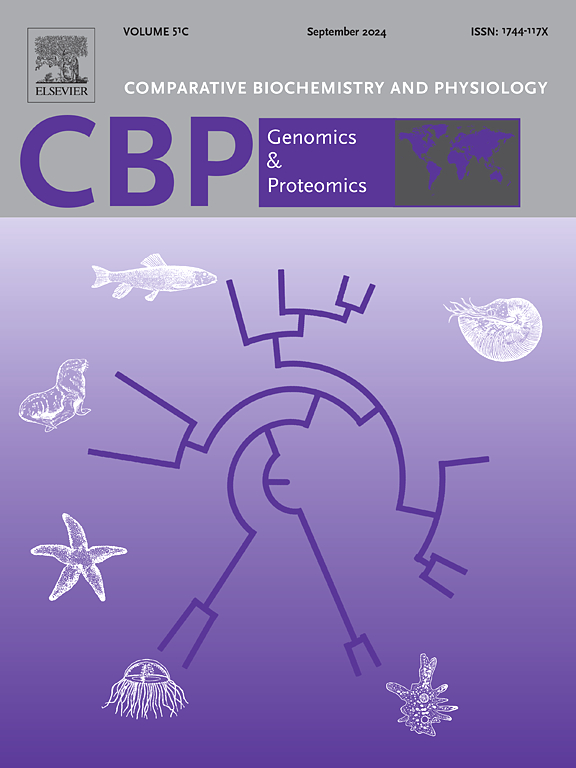Genomic resources and transcriptomic evidence of thermal stress in the southern saucer scallop (Ylistrum balloti)
IF 2.2
2区 生物学
Q4 BIOCHEMISTRY & MOLECULAR BIOLOGY
Comparative Biochemistry and Physiology D-Genomics & Proteomics
Pub Date : 2025-06-24
DOI:10.1016/j.cbd.2025.101571
引用次数: 0
Abstract
Marine heatwaves can lead to mass mortality events, affecting bivalves. The saucer scallop (Ylistrum balloti) is an important commercial species found in Western Australia (WA) and central Queensland. The largest fishery for this species in WA is at Shark Bay, on the central WA coastline. The fishery has been impacted by heatwaves in the recent past and has yet to fully recover. Whether thermal pressures are influencing the fishery's recovery is uncertain, as other factors, including larval advection, could also influence recovery. A functional genomics approach was used to address this uncertainty. Scallops were collected from multiple locations in Shark Bay with different water temperatures and from a small, more southerly fishery adjacent to Perth. A full genome was assembled. The genome contains comparatively few gene copies of heat shock protein 70, an important indicator of thermal stress, particularly from class 12, which has been highly duplicated in other heat tolerant bivalves. Transcriptomic profiles in scallops collected from the different locations were compared, with the greatest differences observed in scallops collected from an area of Shark Bay with the warmest water temperatures. Some transcripts with altered abundance encoded heat shock proteins, proteins involved in macromolecule repair, and those with a primary metabolism role. Although this study is a snapshot of a few individuals at a single time point, it adds to the weight of evidence that extreme heatwave events and climate change impacts the recruitment of this commercially important species.

南方扇贝(Ylistrum balloti)热胁迫的基因组资源和转录组学证据
海洋热浪会导致双壳类动物大量死亡。碟形扇贝(Ylistrum balloti)是一种重要的商业物种,发现于西澳大利亚(WA)和昆士兰州中部。西澳最大的鱼场是西澳中部海岸线上的鲨鱼湾。渔业在最近的过去受到热浪的影响,尚未完全恢复。温度压力是否影响渔业的恢复是不确定的,因为其他因素,包括幼虫平流,也可能影响恢复。功能基因组学方法被用来解决这种不确定性。扇贝是从鲨鱼湾不同水温的多个地点和靠近珀斯的一个更偏南的小型渔场收集的。一个完整的基因组被组装起来。基因组中含有相对较少的热休克蛋白70基因拷贝,热休克蛋白70是热应激的重要指标,特别是来自12类,在其他耐热双壳类中高度复制。从不同地点收集的扇贝的转录组谱进行了比较,从鲨鱼湾水温最高的地区收集的扇贝差异最大。一些丰度改变的转录本编码热休克蛋白、参与大分子修复的蛋白和具有主要代谢作用的蛋白。虽然这项研究只是在一个时间点上对少数个体的快照,但它增加了极端热浪事件和气候变化影响这种商业上重要物种招募的证据的权重。
本文章由计算机程序翻译,如有差异,请以英文原文为准。
求助全文
约1分钟内获得全文
求助全文
来源期刊
CiteScore
5.10
自引率
3.30%
发文量
69
审稿时长
33 days
期刊介绍:
Comparative Biochemistry & Physiology (CBP) publishes papers in comparative, environmental and evolutionary physiology.
Part D: Genomics and Proteomics (CBPD), focuses on “omics” approaches to physiology, including comparative and functional genomics, metagenomics, transcriptomics, proteomics, metabolomics, and lipidomics. Most studies employ “omics” and/or system biology to test specific hypotheses about molecular and biochemical mechanisms underlying physiological responses to the environment. We encourage papers that address fundamental questions in comparative physiology and biochemistry rather than studies with a focus that is purely technical, methodological or descriptive in nature.

 求助内容:
求助内容: 应助结果提醒方式:
应助结果提醒方式:


